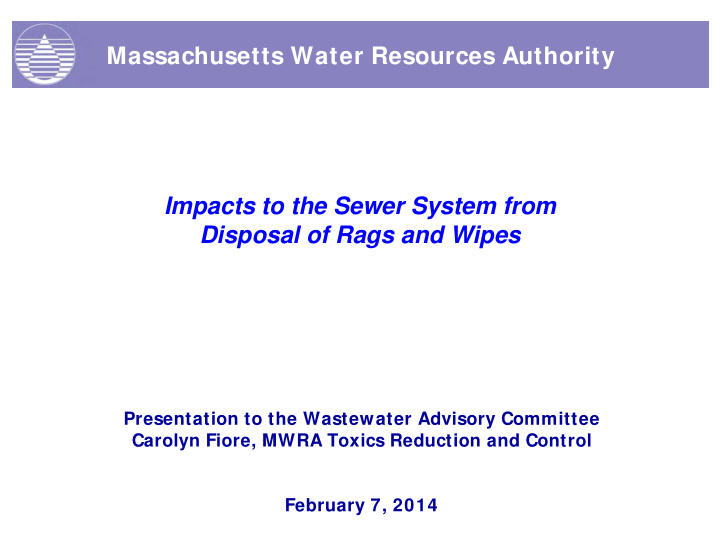



Massachusetts Water Resources Authority Impacts to the Sewer System from Disposal of Rags and Wipes Presentation to the Wastewater Advisory Committee Carolyn Fiore, MWRA Toxics Reduction and Control February 7, 2014
Braintree- Weymouth Pump Station 2
Braintree- Weymouth Pump Station 3
Storm Summary – February 27, 2013 • Rain Gauge @ Chelsea OCC: 1.79 inches • Staff began choking BWPS at 6:20 pm on February 27 due to high flows entering the facility. • Elevation in wet well reached a “high high” causing the facility to briefly isolate. • South Main Pump Station - recorded maximum average hourly flow of 349 MG • Smelt Brook overflowed from 9:22 pm until 1:30 am. • Numerous rags were removed from the pump wet well and influent grinders. 5
Braintree-Weymouth Pump Station I mpacts • Excessive number or rags entering the system has been associated with clogging of grinders and pumps. 6
Short-Term Reponses at BWPS Short Term Response • Cleaned wet well, pumps and screens 7
Short-Term Reponses at BWPS Short Term Response • Installed temporary screens 8
Short-Term Reponses at BWPS Short Term Response • Installed new grinder 9
Short-Term Reponses at BWPS Short Term Response • Installed quick disconnects 10
Short-Term Reponses at BWPS Short Term Response • Bypass pumping and buried lines 11
Long-Term Responses at BWPS Long-Term Response • Perform Hydraulic and Equipment Evaluations • Alternative Evaluations include: New pumps to reduce rag accumulation and clogging Alternative Grinder Technologies Potential to install mechanically cleaned bar screens Including washer compacter Conveyors to remove debris Alternative Pumping Strategies To reduce sediment and rag accumulation 12
TRAC Responses • Reviewed TRAC Database to develop a list of potential source sites • Developed a list of facilities to be inspected based on the nature of the rags indentified at the site. • Staff inspected numerous facilities throughout the target area. • Contacted municipalities to determine which town may have performed sewer maintenance prior to the event. • Inspected septage sites and reviewed manifests for the facilities • Sent rag samples to laboratory (Altran) for forensic review 13
TRAC Permitted Sites 14
Septage Facility 15
ALTRAN Forensic Analysis of Six Rags 17
Summary of ALTRAN findings • Rag samples collected from BWPS, a septage receiving site and 2 upstream manholes • The common contaminant for these samples, excluding the expected sewage products, is a petroleum –based oil formulation resembling light machine oil. • Rags appear to be consistent 18 inch multiples in length, polyester, and appear to have been torn off of a round roll of cloth. • No specific manufacturer or distributor could be identified, but if we find a suspected source, we now have a contaminant fingerprint to match. 18
Ubiquitous Nature of the Problem 19
Outreach and Education MWRA has begun outreach regarding proper disposal of wipes and other materials. • MWRA school education program: 2014 Essay, Poster and Video Contest • Web-site Update with What not to Flush page MWRA is considering: • Billboard Messages • Outreach to Senior Community Centers/Developments • Social Media such as YouTube, Industry Facebook pages and Twitter feeds • Links to Town Web-sites • Coordinate an information television news piece 20
MWRA.COM Website Updated • http://www.mwra.com/03sewer/html/toiletnottrashcan.html 21
Summary • Equipment and operation changes at the BWPS • TRAC Inspection and Follow-up • Outreach /Public Education Development 22
Recommend
More recommend